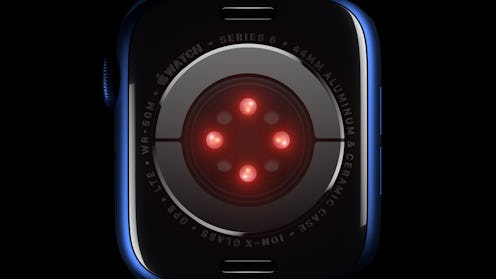Health
The New Apple Watch Measures A Possible COVID-19 Indicator
You may have never thought about your blood oxygen levels pre-pandemic.
With flu season coming up in the midst of a pandemic, you might be more conscious of your health than usual. If you're looking for a simple way to check in on your general wellness on the daily, the Apple Watch Series 6 will be able to measure your blood oxygen levels.
According to a press release from Apple, the Apple Watch Series 6, announced during Apple's annual keynote on Sept. 15, will come complete with a Blood Oxygen app you can sync with your iPhone. From there, you'll be able to use your watch to see how well your body is processing the oxygen you need to function efficiently as a human. The Watch will use LED and infrared light to measure how much oxygen your red blood cells are carrying at any given time.
Why is blood oxygen important? According to the British Lung Foundation, figuring out your oxygen saturation (the fancy term for the level of oxygen in your blood) can help you monitor your lung or heart health. Basically, you want over 90 to 92% of your blood or more to be carrying oxygen molecules with it at any given time — lower than that could be an indicator of poor lung function — and most people's blood saturation hovers at 95% or above. Your body needs all that oxygen to fuel everything from running and laughing to digesting and sitting there having a good old-fashioned daydream.
Keeping track of your blood oxygen levels might be especially important during the pandemic. COVID-19 impacts the lungs and respiratory system, which can affect how well your lungs pump oxygen out to your bloodstream. According to Houston Methodist Hospital, even people who have COVID but are asymptomatic can experience low blood oxygen levels. Knowing your levels might be able to serve as a rough early signal of COVID-19, though you can have low blood oxygen levels without having COVID-19, or be positive for the illness without it affecting your blood saturation. Doctors often use pulse oximeters — inexpensive devices that also measure blood oxygen levels via fingertip readings — to help COVID-19 patients manage their cases, Business Insider reported. Blood oxygen level readings are also helpful for asthma and heart or lung disease patients.
The Apple Watch's measurements aren't intended for medical use or self-diagnosis — if you get a reading that concerns you, or think you may have COVID-19, you should talk to your doctor immediately — but it is a useful metric of general wellness you can take at home. More research on the link is on the horizon, though: Apple is coordinating with UW Medicine to follow participants through the 2020 flu season, to see Apple Watch-detected measurements like heart rate or blood oxygen levels can reliably identify COVID or flu symptoms early on.
If you want to use the Blood Oxygen function (and it's available in your country), you'll toggle it on in your phone's Health app. When you're feeling curious, you can open the app on your Watch and stay still for at least 15 seconds with the watch face snug against the top side of your wrist. The Watch will send infrared, red, and green LED lights into your body. From the light reflected back, it can measure how red your blood is (AKA how much oxygen it has) and use its algorithms to figure out what percentage of your blood is bringing oxygen along for the ride. It'll also take background readings of your blood oxygen level, so if you sleep with your Apple Watch on, you'll be able to see your levels change over time.
Your Apple Watch won't be able to replace a visit to your doctor, but it might be able to give you some insight into what your insides are up to.
